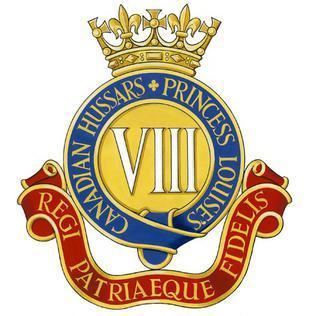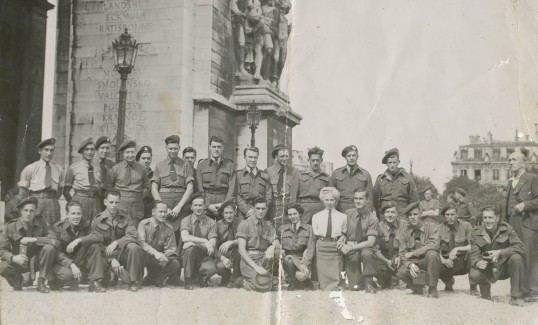Active 1869–present Type Line cavalry Nickname(s) The Crazy Eights | Branch Primary Reserve Role Reconnaissance March "The 8th Hussars" Engagement World War II | |
 | ||
Motto "Faithful to King and Country" Part of Royal Canadian Armoured Corps Profiles | ||
The 8th Canadian Hussars (Princess Louise's) is the longest serving armoured regiment in the Canadian Army. It was formed on the 4 April 1848 in New Brunswick where it has served continually ever since. Today it is a reserve armoured reconnaissance regiment with 2 Squadrons. Its Regimental Headquarters(RHQ)and A Squadron is located in Moncton with B Squadron located in Sussex, New Brunswick.
Contents
- History
- South African War
- The Great War
- The Second World War
- Post World War II
- War in Afghanistan
- Lineage chart
- Battle honours
- The War of 1812
- Afghanistan
- 8th Hussars Regimental Museum
- War of 1812
- Alliances
- References

In 1957 its name, 8th Canadian Hussars (Princess Louise's), was chosen for the formation of a new regular force regiment to serve in addition to the reserve regiment. The Regular Regiment served in Gagetown, New Brunswick, Petawawa, Ontario, the Sinai, Cyprus, Iserlohn (Fort Beausejour), Soest and Lahr, West Germany. The Regular force regiment was disbanded in 1998. The reserve regiment of the 8th Canadian Hussars (Princess Louise's) remains.

History
The earliest beginnings of the 8th Canadian Hussars (Princess Louise's) have traditionally been traced to the year 1775 in the Colony of Virginia where Captain John Saunders, of Princess Anne County, raised a troop of cavalry at his own expense to fight for the Crown against the Colonial rebels. This unusual Regiment included riflemen, grenadiers, artillery and cavalry, and it never knew defeat during the American conflict for independence. In September 1783, the Regiment as an entity sailed for Nova Scotia and reached Saint John on 27 September 1783. A large number of these Loyalists soldiers settled in the Saint John and Kennebecasis valleys by Loyalist soldiers, had a military tradition and indeed an effective militia. In 1839, the York County Troop, known for a time as the York Light Dragoons, was mobilized for service in the Aroostook War, a conflict with American lumbermen that never quite came to open fighting. For four months they patrolled the border and roads between Woodstock, Fredericton and Saint John. By 1848, eleven troops of cavalry were in existence. These troops included Hampton Troop of Cavalry, Assekeag Troop of Cavalry, Apohaqui Troop of Cavalry, Upham Troop of Cavalry, Johnston Troop of Cavalry, Shediac Troop of Cavalry, Springfield Troop of Cavalry, among others.
By authority of Militia General Order No 1 of 4 April 1848, these eleven independent troops were united to form a Regiment entitled the New Brunswick Yeomanry Cavalry. It is this date that is officially recognized as the formation date of the 8th Canadian Hussars.
South African War
The regiment contributed volunteers for the Canadian Contingents that served in South Africa.
The Great War
The 6th Regiment, Canadian Mounted Rifles Battalion, CEF, was authorized on 7 November 1914 and embarked for England on 17 July 1915. It disembarked in France on 24 October 1915, where it continued to train until 2 January 1916 when its personnel were absorbed by the 4th Battalion, Canadian Mounted Rifles and the 5th Battalion, Canadian Mounted Rifles, CEF. The regiment disbanded on 18 February 1918.
The Second World War
The Second World War provided the regiment’s first opportunity for active service as a formed unit. The regiment mobilized as the 4th Canadian Motorcycle Regiment, CASF (8 NBH) on 24 May 1940. It was converted to armour and redesignated as the "8th Princess Louise's (New Brunswick) Hussars) CAC, CASF", on 9 February 1941; as the 5th Armoured Regiment (8th Princess Louise's (New Brunswick) Hussars, CASF, on 11 February 1941. The regiment embarked for Britain on 9 October 1941
The regiment landed in Italy on 19 December 1943 as a unit of the 5th Armoured Brigade, 5th Canadian Armoured Division. It was renamed as the "5th Armoured Regiment (8th Princess Louise's (New Brunswick) Hussars, CAC, CASF", on 15 October 1943. The regiment landed in Italy on 19 December 1943 at Naples and saw action soon and frequently thereafter. The regiment fought in the Liri Valley, the Melfa Crossing, Ceprano, The Gothic Line, Missano Ridge, Coriano, the Lamone River Crossing, and Coventello where it distinguished itself.
It moved to North-West Europe on 17 February 1945 as part of Operation Goldflake. The Hussars sailed from Italy to Southern France, and then moved by rail to Northwest Europe. After refitting the tanks, the regiment went into action in the Netherlands, breaking through to Putten in mid-April. The regiment then moved north for the final actions of the war at the Delfzijl Pocket where 3,000 German soldiers surrendered to the regiment. It was renamed as the "5th Armoured Regiment (8th Princess Louise's (New Brunswick) Hussars, RCAC, CASF", on 2 August 1945.
On 26 January 1946, the regiment arrived in Halifax and the next day reached Sussex, New Brunswick where it was demobilized. The overseas regiment disbanded on 15 February 1946.
Post World War II
In 1950, the regiment was called upon to provide men for service with the Special Force which was raised and deployed to Korea, and in 1951 "Y" Troop was organized for service with the 27th Canadian Infantry Brigade in Germany.
On 29 January 1957, it was decided that a third armoured regiment would be formed in the Canadian Army. As a result, the regiment was honoured with the privilege of providing its name to the new regiment. This resulted in the change of the regiment’s name to the 8th Canadian Hussars (Princess Louise’s). The Regular Regiment served in Gagetown, New Brunswick, Petawawa, Ontario, the Sinai, Cyprus, Iserlohn (Fort Beausejour), Soest and Lahr, West Germany.
Cpl. Paul R. Wallace and Tpr. Adrian A. Bons died while deployed to the Sinai as part of the United Nations Emergency Force on 27 November 1964.
In the summer of 1965, the regiment was deployed from their base at Petawawa, Ontario on a peacekeeping mission for the United Nations to the island nation of Cyprus. Tpr. Lennard W. Nass died on 27 September 1966 while deployed to Cyprus as part of the United Nations Force in Cyprus.
The regiment has participated in several "aid to the civil authority" missions in recent history. In the summer of 1990 the regiment sent a troop sized force to the province of Quebec in Cougars to assist in Canadian Forces Operations in the Oka Crisis. In the 1998 Ice Storm, the regiment provided a platoon-sized force to assist in the maintenance of infrastructure in the community of St. George, New Brunswick. In the fall of 1998, the regiment provided soldiers to the recovery effort for Swiss Air Flight 111.
In 2004, 8CH became an armoured reconnaissance unit, in place of its previous designation as simply an armoured unit. Along with this trade change the unit was given the new Mercedes-Benz G-Wagon, a Jeep-like vehicle more suited to their new role as reconnaissance. The unit is stationed at the Moncton and Sussex detachments of CFB Gagetown, New Brunswick. Its Colonel-in-Chief is HRH The Princess Royal.
War in Afghanistan
The regiment contributed an aggregate of more than 20% of its authorized strength to the various Task Forces which served in Afghanistan between 2002 and 2014.
Lineage chart
Lineage of the units of the 8th Canadian Hussars:
Battle honours
In the list below, battle honours in capitals were awarded for participation in large operations and campaigns, while those in lowercase indicate honours granted for more specific battles. Those battle honours followed by a "+" are emblazoned on the regimental guidon.
The War of 1812
The Great War
The Second World War
Afghanistan
Afghanistan
8th Hussars Regimental Museum
The regiment's museum is located in a former train station in Sussex, New Brunswick. Exhibits focus on the 8th Canadian Hussars (Princess Louise's) military history and activities, and include uniforms, medals, weapons and artifacts from different wars.
